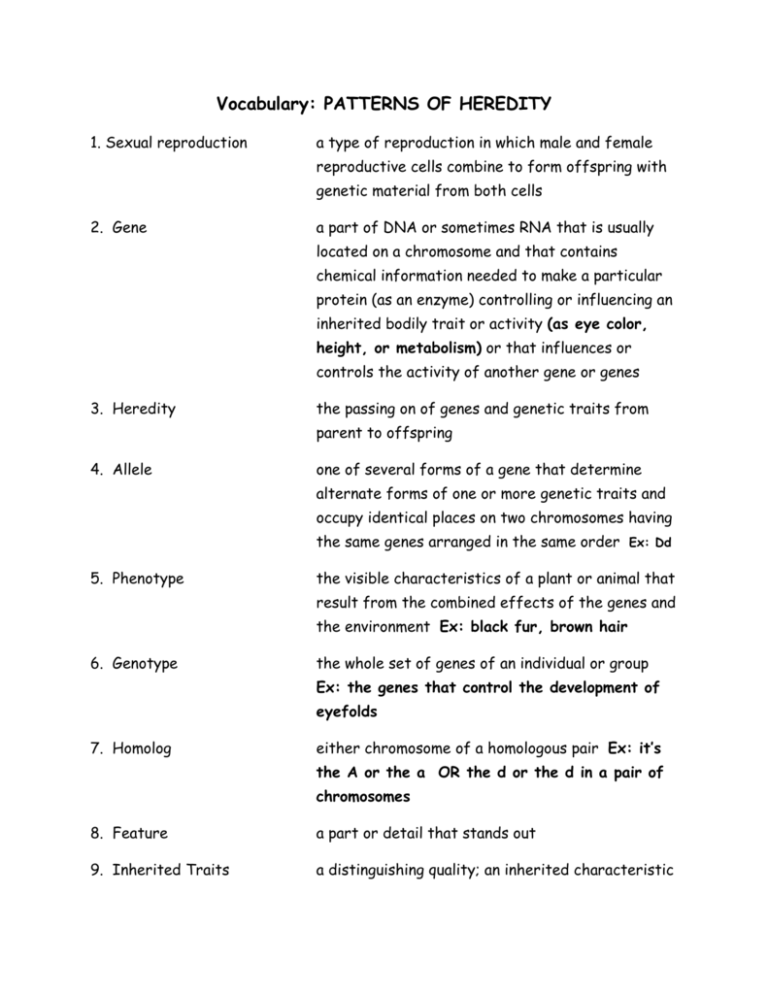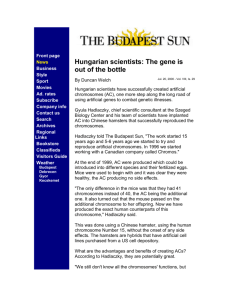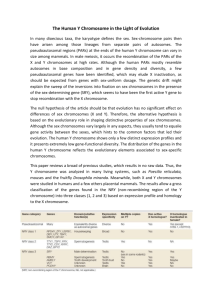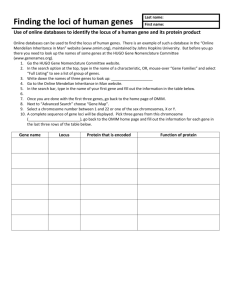Vocab. Patterns of Heredity
advertisement

Vocabulary: PATTERNS OF HEREDITY 1. Sexual reproduction a type of reproduction in which male and female reproductive cells combine to form offspring with genetic material from both cells 2. Gene a part of DNA or sometimes RNA that is usually located on a chromosome and that contains chemical information needed to make a particular protein (as an enzyme) controlling or influencing an inherited bodily trait or activity (as eye color, height, or metabolism) or that influences or controls the activity of another gene or genes 3. Heredity the passing on of genes and genetic traits from parent to offspring 4. Allele one of several forms of a gene that determine alternate forms of one or more genetic traits and occupy identical places on two chromosomes having the same genes arranged in the same order Ex: Dd 5. Phenotype the visible characteristics of a plant or animal that result from the combined effects of the genes and the environment Ex: black fur, brown hair 6. Genotype the whole set of genes of an individual or group Ex: the genes that control the development of eyefolds 7. Homolog either chromosome of a homologous pair Ex: it’s the A or the a OR the d or the d in a pair of chromosomes 8. Feature a part or detail that stands out 9. Inherited Traits a distinguishing quality; an inherited characteristic 10. Self-pollination pollination of a flower by its own pollen or sometimes by pollen from another flower on the same plant 11. Cross Pollination the transfer of pollen from one flower to the stigma of another 12. Gregor Mendel is considered by many to be the "Father of Modern Genetics" - he discovered the patterns between 'parent' pea plants and their offspring, including the same pea color and plant size 13. First Generation the first offspring generation (f1) 14. Second Generation the next generation is referred to as f2 15. Variation divergence in the structural or functional characteristics of an organism from the species or population norm or average 16. Chromosome any of the rod-shaped or threadlike DNAcontaining structures of cellular organisms that are located in the nucleus of eukaryotes, are usually ring-shaped in prokaryotes (as bacteria), and contain all or most of the genes of the organism Ex: BB or Bb or Gg 17. X-chromosome a sex chromosome that is associated with femaleness and usually occurs paired in each female cell and single in each male cell in organisms (as human beings) in which the male normally has two unlike sex chromosomes Ex: XX 18. Y-chromosome a sex chromosome that is associated with maleness and occurs only in male cells paired with an X chromosome in organisms (as human beings) in which the male normally has two unlike sex chromosomes Ex: XY 19. Homozygous Gene having the two genes at corresponding loci on homologous chromosomes identical for one or more loci 20. Heterozygous Gene having the two alleles at corresponding loci on homologous chromosomes different for one or more loci 21. Dominant being the one of a pair of bodily structures that is the more effective or predominant in action Ex: it’s the D in Dd 22. Recessive producing a bodily characteristic (as eye color) when homozygous and not masked by a copy of the gene that is dominant Ex: It’s the d in Dd 23. Punnett Square an n × n square used in genetics to calculate the frequencies of the different genotypes and phenotypes among the offspring of a cross 24. Gamete a mature sex cell that usually has half of the normal number of chromosomes and is capable of uniting with a gamete of the opposite sex to begin the formation of a new individual 25. Probability the chance that a given event will occur 26. Pedigree a table or list showing the line of ancestors of a person or animal











